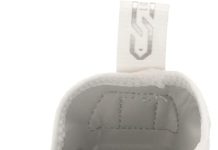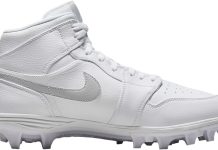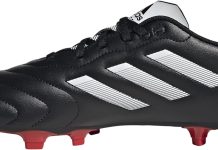Are you excited to lace up your brand new pair of football cleats but unsure of how to properly break them in? Don’t worry, we’ve got you covered! Breaking in new cleats is essential to ensure maximum comfort and performance on the field. In this article, we will share some tried and true methods to help soften those new shoes, so you can hit the ground running with confidence.
Understanding the Importance of Breaking in Football Cleats
Review contents
Why is it necessary to break in new cleats?
Breaking in new football cleats is crucial for a variety of reasons. When you first purchase a pair of cleats, they are typically stiff and rigid due to the materials used in their construction. Breaking them in helps to mold the cleats to the shape of your feet, providing a more comfortable fit and reducing the risk of blisters and foot pain. Additionally, breaking in your cleats improves their overall performance by enhancing your agility, responsiveness, and traction on the field. So, it is important to allocate some time and effort to properly break in your cleats before wearing them in competitive games.
What are the potential risks of not breaking in your cleats?
Choosing not to break in your cleats can lead to several potential risks. Firstly, wearing new cleats that are not broken in can cause discomfort and pain during physical activity. The stiffness of the material can rub against your skin, resulting in blisters, calluses, and even cuts. Moreover, ignoring the break-in process can negatively impact your performance on the field. Without properly molded cleats, you may experience a lack of stability and traction, making it more difficult to change direction, accelerate, and decelerate effectively. This can increase your chances of slipping, losing your footing, and potentially suffering from an injury. Therefore, taking the time to break in your cleats is essential for your comfort, performance, and overall safety during football activities.
Preparing Your Cleats for Initial Use
Inspecting the cleats for any defects
Before breaking in your cleats, it is important to inspect them thoroughly for any defects. Check for any loose or missing screws, damaged studs, or tears in the material. Examine the stitching and make sure it is intact. By conducting a detailed inspection, you can identify any issues early on and have them addressed or replaced before trying to break in your cleats.
Ensuring the cleats properly fit
A proper fit is essential for both comfort and performance when it comes to football cleats. Make sure your cleats are the correct size and width for your feet. They should provide a snug fit without being too tight or too loose. It is advisable to try on the cleats with the same socks you will wear during games to ensure accurate sizing. Keep in mind that your feet may swell during physical activity, so leave some room for slight expansion. When trying on the cleats, walk around and perform some basic movements to assess their comfort and fit.
Applying leather conditioner (if applicable)
If you have chosen leather cleats, it is recommended to apply a leather conditioner before breaking them in. Leather conditioner helps to soften the material and make it more pliable, reducing the likelihood of discomfort and blisters. Follow the manufacturer’s instructions on applying the conditioner and allow it to fully absorb into the leather before proceeding with the break-in process.
This image is property of i.ytimg.com.
Gradual Use for Optimal Comfort
Start by wearing your cleats around the house
To begin breaking in your cleats, it is a good idea to wear them around the house for short periods. This allows your feet to adapt to the new cleats slowly without placing excessive strain on them. While wearing the cleats, try walking, standing, and flexing your feet to help loosen up the material. Take note of any areas of discomfort or pain and pay particular attention to those spots during subsequent break-in sessions.
Wear them during light physical activities
After wearing your cleats around the house, it’s time to gradually introduce them to light physical activities. Start by wearing them during a light jog or a casual kick-around with friends. This helps to further break in the cleats and allows your feet to get accustomed to the movements required in football. Again, pay attention to any areas of discomfort and adjust accordingly.
Increase usage for short practice sessions
As your cleats become more comfortable, you can slowly increase their usage during short practice sessions. Begin by wearing them for a portion of your regular training session, focusing on basic movements such as running, stopping, and changing directions. By gradually incorporating your cleats into practice, you give your feet the opportunity to adjust and adapt without overwhelming them. Remember to listen to your feet and take breaks if needed to prevent any excessive discomfort.
Wearing Cleats During Practice Sessions
Using cleats during non-competitive practices
Once your cleats are adequately broken in and you feel comfortable wearing them for extended periods, it’s time to start using them during non-competitive practice sessions. This allows you to further refine your skills while becoming fully accustomed to the performance of your cleats. Non-competitive practices provide a lower-pressure environment where you can focus on improving your technique, ensuring that your cleats are well-suited to your playing style.
Performing basic movements to break them in
During practice sessions, it’s important to focus on performing a variety of basic movements to fully break in your cleats. This includes running, sprinting, changing directions, pivoting, and stopping abruptly. By engaging in these fundamental football movements, you can further mold the cleats to your feet and improve their overall responsiveness.
Gradually incorporating more intense drills
As you continue wearing your cleats during practice, gradually introduce more intense drills that mimic game situations. These drills may involve quick acceleration, sudden stops, lateral movements, and jumping. By incorporating more intense drills, you challenge your cleats and ensure they are capable of providing the necessary support and traction during high-intensity situations.
This image is property of photos.demandstudios.com.
Ensuring Proper Care and Maintenance
Cleaning your cleats after each use
Proper care and maintenance are essential for ensuring the longevity and performance of your cleats. After each use, take the time to clean your cleats to remove dirt, grass, and any other debris. Use a soft brush or cloth to gently scrub the exterior, including the outsole and studs. This helps to prevent any buildup that may affect the traction and durability of the cleats.
Allowing them to air dry
After cleaning your cleats, allow them to air dry in a well-ventilated area. Avoid using heat sources such as direct sunlight or heaters, as excessive heat can damage the materials. It is important to note that wearing wet cleats can lead to uncomfortable conditions and potential mold growth, so ensure they are completely dry before wearing them again.
Storing them in a cool and dry place
When not in use, it is crucial to store your cleats in a cool and dry place. Excessive heat and humidity can cause the materials to deteriorate, leading to reduced performance and durability. Avoid leaving your cleats in a damp environment, such as a gym bag, as this can promote the growth of bacteria and mold. Instead, choose a well-ventilated area where the cleats can air out and remain in optimal condition.
Addressing Discomfort and Hotspots
Identifying areas of discomfort
During the break-in process, it is common to experience areas of discomfort or hotspots on your feet. These are areas where the cleats may rub or create undue pressure. It is important to identify these areas early on to prevent the development of blisters and other foot issues. Pay attention to any rubbing or pain during practice sessions and take note of the specific areas affected.
Using moleskin or band-aids for prevention
To alleviate discomfort and prevent blisters, it is recommended to use moleskin or band-aids on the affected areas of your feet. Apply these protective materials before wearing your cleats to provide an extra layer of cushioning and reduce friction. Moleskin and band-aids act as a barrier between your skin and the potentially irritating parts of the cleats, allowing you to continue breaking them in without excessive discomfort.
Adjusting laces and straps for a snug fit
If you find that certain areas of your cleats are consistently causing discomfort, consider adjusting the laces and straps for a snug fit. Loosen the laces or straps in areas where there is excessive pressure, and tighten them in areas that require additional support. By customizing the fit of your cleats, you can help alleviate discomfort and ensure a more secure and comfortable fit.
This image is property of www.stgsoccerskills.com.
Seeking Professional Advice
Consulting with a podiatrist or sports specialist
If you continue to experience significant discomfort or foot issues, it is advisable to seek professional advice from a podiatrist or sports specialist. These professionals can assess your foot structure, analyze your gait, and provide customized recommendations. They may suggest specific exercises or treatments to alleviate discomfort, or even recommend alternative cleats or orthotics tailored to your individual needs.
Receiving custom orthotics or insoles
In some cases, a podiatrist or sports specialist may recommend custom orthotics or insoles to be worn inside your cleats. These devices are designed to correct any biomechanical imbalances or provide additional cushioning and support in areas prone to discomfort. Custom orthotics or insoles can significantly enhance the comfort and performance of your cleats, particularly if you have pre-existing foot conditions or imbalances.
Exploring alternate cleat options if required
If all else fails and you are unable to find relief from discomfort or pain, it may be necessary to explore alternate cleat options. Different brands and models of cleats offer varying features and designs that may better suit your feet and playing style. Consult with knowledgeable sales staff or sports specialists to discuss alternative options that may alleviate your discomfort and enhance your performance.
Gradually Introducing Cleats in Competitive Games
Starting with shorter game time
Once your cleats are adequately broken in and you have gained confidence in their performance, you can start introducing them in competitive games. However, it is recommended to start with shorter game time initially. This allows your feet to adjust to the increased intensity and prolonged periods of activity without overwhelming them. Gradually increase your game time as your feet become more comfortable and accustomed to the demands of competitive play.
Using them in low-pressure matches
When introducing your cleats in competitive games, consider starting with low-pressure matches. These may include friendly matches or games with a lower level of competitiveness. Lower-pressure matches provide valuable opportunities to fine-tune your performance while further breaking in your cleats. It also allows you to assess their effectiveness in a game situation and make any necessary adjustments before facing more challenging opponents.
Increasing usage as you gain confidence
As you gain confidence in the performance and comfort of your cleats, gradually increase their usage in more competitive games and higher-pressure situations. This allows you to fully capitalize on the advantages provided by your well-broken-in cleats, such as superior traction, agility, and responsiveness. By the time you reach important matches or tournaments, your cleats will have become an integral part of your game, enhancing your performance and contributing to your success on the field.
This image is property of www.footy-boots.com.
Replacing Cleats When Necessary
Knowing when it’s time for a replacement
No matter how well you break in your cleats and take care of them, there comes a time when they need to be replaced. Several indicators can help you determine when it’s time for a new pair of cleats. If you notice significant wear on the outsole or studs, decreased traction, or visible damage to the upper material, it is a strong indication that a replacement is necessary. Additionally, if you experience persistent discomfort or pain that cannot be resolved through adjustments or customization, it may be time to consider a new pair of cleats.
Considering wear and tear indicators
Inspecting your cleats regularly for signs of wear and tear is essential in knowing when it’s time for a replacement. Look for any separation between the upper and outsole, excessive creasing or cracking of the material, or worn-down studs. It’s also important to pay attention to the overall condition of the cleats, including the laces, eyelets, and any additional features or technologies they may have. By being proactive in assessing the wear and tear, you can avoid potential performance issues and reduce the risk of injury.
Finding the right time in the season to switch
Timing is crucial when it comes to replacing your cleats. It is generally advisable to plan for a replacement during the off-season or during a period with fewer games and practices. This allows you the opportunity to thoroughly break in and adjust to the new cleats before they are needed in competitive situations. It also ensures that you have sufficient time to evaluate the performance and comfort of the new cleats, making any necessary modifications or adjustments if needed.
Enhancing Durability and Longevity
Choosing high-quality cleats
To ensure the durability and longevity of your cleats, invest in high-quality options from reputable brands. High-quality cleats are constructed with superior materials and craftsmanship, which can significantly enhance their lifespan. Take the time to research different brands and models, read reviews, and choose cleats that are known for their durability and performance. While high-quality cleats may come with a higher price tag, they are a worthwhile investment in your comfort and long-term performance on the field.
Regularly inspecting for signs of wear
Regular inspections are a key aspect of maintaining the durability of your cleats. Beyond the initial wear and tear indicators discussed earlier, make it a habit to routinely check your cleats for any new signs of damage or excessive wear. By identifying and addressing any issues early on, you can prolong the lifespan of your cleats and prevent potential performance setbacks. Remember, proactive maintenance is often more cost-effective than waiting until a major issue arises.
Replacing worn-out components if possible
In certain cases, you may have the option to replace specific components of your cleats instead of purchasing an entirely new pair. For example, if the studs are worn down but the upper material remains in good condition, you can often replace the studs alone. Some cleats also feature removable insoles that can be replaced if they become worn or lose their cushioning properties. By taking advantage of these replacement options, you can extend the lifespan of your cleats while minimizing both cost and environmental impact.
In conclusion, breaking in your new football cleats is a vital step in ensuring optimal comfort, performance, and longevity. By following a gradual break-in process, properly caring for your cleats, addressing discomfort, seeking professional advice if needed, and knowing when to replace them, you can maximize the benefits of your cleats and elevate your game on the football field. Remember, investing time and effort into breaking in your cleats is a small price to pay for the significant improvements they can bring to your performance and overall enjoyment of the game. So, lace up those cleats, take care of them properly, and get ready to excel on the field!
This image is property of funattic.com.










































